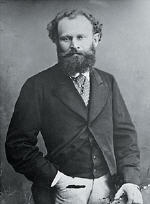
Manet was born in Paris on 23 January, 1832, the eldest son of a high official in the French Ministry. In 1848 he failed the entrance exam to naval college. He subsequently went to sea with the merchant marine to avoid studying law, as his father wished. He became a painter against his father's advice, joining the studio of the respected academic painter Thomas Couture in 1850. Though he remained with Couture for six years, Manet gained his real knowledge of art during visits to Italy in 1853 and 1857, and to Germany and Holland in 1856. Those trips exposed Manet to the same masters who had so profoundly interpreted realism in the past: Hals, Velázquez and Goya. In 1863 Manet participated in the famous Salon des Refuses, an exhibition consisting of works rejected by the official Salon, and he came to be viewed as the hero of the nonconformists. Though Manet regarded himself as working in the tradition of the great masters, his approach was to rethink established themes in modern terms. His early notoriety was based on the subject matter of paintings such as Dejeuner sur l'herb, and Olympia rather than their style. Highly independent, and extraordinarily original in both his unconventional portrayals of modern life and his spontaneous brushwork, he struggled for academic acceptance throughout his life. Although Manet was rebellious in his subject matter, he craved official recognition, and this may be why he never 'compromised' himself by exhibiting at any of the Impressionist exhibitions. He claimed that he had 'no intention of overthrowing old methods of painting, or creating new ones'. Although he never regarded himself as an Impressionist and never exhibited with them, Manet strongly supported their choice of subject matter. Manet's refreshingly direct look at life and his spontaneous yet monumental translation of what he saw into paint earned him the position as their unofficial leader.